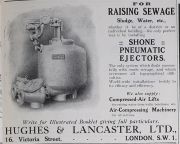Hughes and Lancaster

















Hughes and Lancaster of City Road, Chester; of Acrefair, Ruabon, Wrexham, Denbighshire. Also of 47 and 16 Victoria Street, Westminster, London (1937); see details on adverts.
1865 Company established by John Hughes.
1884 Hughes and Lancaster occupied the "Powder Magazine" at Sealand in the parish of Hawarden, near the right bank of the River Dee[1]
1885 John Hughes and Charles Lancaster gained a Spanish patent on "Improvements in the construction of streetcars and other railway vehicles or carriages moved by compressed air."
1885 Purchased the Coed Talon Colliery Company[2]
1889 Sewage pumping equipment for Yangon, Myanmar. This has been preserved. See here for information and photos [3]
1890 Tramcar was running in Preston on compressed air. Article and illustrations. [4]
1890 Compressed air tramcar: trials at Chester[5] [6]
1892 Two engines for Eastbourne Corporation (Central Compressor Station).
1892 The firm moved to Acrefair near Ruabon.
1892 Isaac Shone and Edwin Ault, both of Wrexham, and John Hughes and Charles Lancaster, both of London, Chester, and Liverpool, trading in co-partnership as Engineers and Contractors, under the style or firm of Hughes and Lancaster, petitioned The Queen to extend Shone's 1878 patent for a further term [7]
1893 Aspects of the works and its equipment were illustrated and briefly described in Engineering 1893/03/31, from which: 'Messrs. Hughes and Lancaster have recently opened new works at Acrefair, near Ruabon, from the designs of Mr. Claude W. Hill, of Manchester, the works occupying the site of the old shops of the “New British Iron Company.” The new works occupy about 36 acres, and will be devoted mainly to the manufacture of Shone’s sewerage plant, air-compressing machine, and plant for the transmission of power by compressed air.'
c.1895 Supplied ejectors, air compressors and related equipment for the Portishead sewerage system [8]. Note: The ejectors were replaced by electric pumps when the system was enlarged [9]
1903 'ENGLISH FIRM'S SUCCESS
An all-European competition for the contract to provide the important city of Oporto in Portugal with a complete drainage system has been won by a London firm of engineers, Messrs Hughes and Lancaster of 47 Victoria Street. Oporto, although the second largest city in Portugal, having an estimated population of nearly 123,000, has, like many Continental towns nearer England, a very primitive system of drainage. The municipal council determined some five years ago to bring their city more up to date in this respect, and the leading engineers and contractors of Europe were invited to submit plans and estimates. It was not, however, until two ago that the council made a final selection resulting in Messrs Hughes and Lancaster gaining one of the most important contracts ever granted by a foreign municipality to an English firm.
What is known as "the separate system " will be adopted in conjunction with Shon[e] ejectors. By this method sewage is automatically raised by compressed air, rendering the aid of gravitation unnecessary. It is a modern system of drainage as yet not introduced in London except in small undertakings. The Houses of Parliament are thus drained, the pneumatic ejectors being situated under Speaker's Green. Messrs Hughes and Lancaster will be required to lay between sixty and seventy miles of sewage pipes under Oporto and construct numerous large ejector stations. The value of the contract has not been disclosed, but it enters well into hundreds of thousands sterling.' [10]
1909 Limited company incorporated to acquire the business carried on by John Hughes and Charles Lancaster, building contractors, engineers and merchants.
1911. Manufacturer of Air Compressors; Ejectors (Shones) for the Railways.[11]
1914 Principals: John Hughes and Charles Lancaster
1914 Manufacturers of Air-compressing machinery, Rock Drills, "Shone" Pneumatic Automatic Ejectors and Sewage and Water-raising Apparatus generally. [12]
1931 With Wilfrid Drake Lancaster, patent on "Improvements relating to wool washing machines and analogous apparatus"
1937 Sewerage engineers. "Shone" Pneumatic Automatic Sewage Ejectors. [13]
By 1951 was a subsidiary of the Butterley Co; an agreement had been reached with Air Products of the USA to licence oxygen-making technology[14]
1957 Name changed to Air Products (Great Britain) Ltd
1960 Company consolidated as Air Products Ltd
See Also
Sources of Information
- ↑ London Gazette 25 November 1884
- ↑ London Gazette 18 Dec 1885
- ↑ [1] Frontier Myanmar website: 'Going underground: upgrading Yangon’s colonial-era sewers', by KYAW LIN HTOON, May 29, 2018
- ↑ The Engineer 1890/03/21 p235
- ↑ Engineering 1890/03/14
- ↑ Engineering 1890/03/21
- ↑ London gazette 12 Feb 1892
- ↑ Clevedon Mercury - 6 May 1899
- ↑ Clevedon Mercury - 11 January 1947
- ↑ Aberdeen Press and Journal, 4 December 1903
- ↑ Bradshaw’s Railway Manual 1911
- ↑ 1914 Whitakers Red Book
- ↑ 1937 The Aeroplane Directory of the Aviation and Allied Industries
- ↑ The Times, Jul 09, 1951
- The Steam Engine in Industry by George Watkins in two volumes. Moorland Publishing. 1978. ISBN 0-903485-65-6

